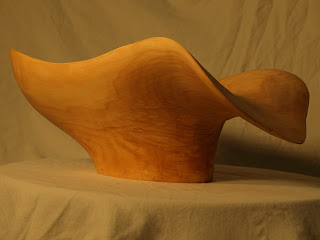Last week I delivered a buffet cabinet to a very happy customer. In the hallowed space which the buffet now stands there was once a china cabinet. The cabinet was nothing special just run of the mill veneered parts screwed together in a factory years ago.
I agreed to deliver it on my return trip to her daughter as she was taking ownership of the china cabinet and planning to refinish it. During the journey I was required to make frequent stops at various shopping outlets. The trip through the parking areas and streets were akin to a nice jaunt across the Australian outback whilst chasing down kangaroo's.
On arrival at our last stop before the trip home I found that one of the lower cabinet doors had completely freed itself from it's hinges. I neglected to tie the door handles together to keep them closed. Silly me.
Well I can't leave it like that. So home it came with me and landed in the shop for some touch ups. Figured I might as well strip the finish for her and save her some time and mess. She also wanted the bonnet on top removed. My eyes wandered over the cabinet and of course I detected some things that could use a little upgrading.
This is how the cabinet looked when it arrived Sunday night.
The back of the cabinet was in rough shape and coming loose of the back. It also is not properly trimmed out ragged edges everywhere on the rear face.
This is the cabinet Monday after I saw a couple of spots that could use improvements. The veneers are coming apart in the plywood on the lower doors. I'll make some simple new ones. Also a new back frame and panel. The base of the upper part has a huge hole in the veneer, need to fix that. This is as far as I got as I was putting a load of rough lumber into the shed after removing it from the old barn in the orchard and cleaning up some junk around the yard all day.
Here we are on Tuesday morning. It is easier to strip the finish if I take the top cabinet apart. Rear panel on the lower part is the same story as above and the bottom shelf is a sorry looking thing and the glue is letting go on the joints.
I'll huff and I'll puff and blow your house down.
Yup, just making a couple improvements
For the rest of this day things are going well. The side assemblies are stripped and clean as well are the shelves for the upper cabinet and it's sides. The bottom shelf of the lower cabinet has been improved and reassembled in it's frame. The dust shelf frame under the drawer space is reassembled as well. I'll finish the day laying out some rabbets on the rear legs to accept the new back panel assembly and collect my thoughts.
This is Wednesday
All parts stripped of old finish. New back panel installed and lower cabinet back together. Reshaped the bottom of the side panels. New skirt on the bottom with cloud lifts giving it that Greene and Greene look. Also the section on top was replaced as the old one didn't go with the new motif. I'll have to go back and pick up the drawer though, it was still full when we picked this up.
This is what things should look like when it is back together.
Unfortunately I will be out of the shop Thursday and Friday. But more fortunately Shannon and I will be leaving for Cuba on Saturday for seven days. Ola.
thanks for stopping by.
Ken


































